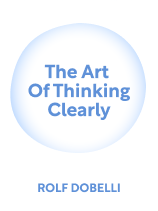

This article is an excerpt from the Shortform book guide to "The Art of Thinking Clearly" by Rolf Dobelli. Shortform has the world's best summaries and analyses of books you should be reading.
Like this article? Sign up for a free trial here .
What are cognitive errors? Why does the brain make these errors, and how can you override them?
Humans have evolved to pay attention to the most memorable or flashy information that comes up, rather than the most pertinent or helpful. The more conspicuous and repeated a piece of information is, the more you’ll believe it. Although it saves the brain’s resources (it takes less time and energy to accept the flashiest information), it results in cognitive errors—faulty ways of thinking that are often inaccurate and/or irrational.
Here are some of the most common cognitive errors that result from the brain’s tendency to save resources.
The Salience Effect
The first cognitive error we’ll look at is the salience effect. Dobelli notes that your brain latches onto unusual or notable factors of a situation and gives these factors too much credit for causing the situation. (Shortform note: The salience effect relies on your past experiences. You might notice certain unusual details due to, for instance, your career or past experiences, while someone else would notice different details.)
Popular attention influences which factors the salience effect focuses on, Dobelli adds. For example, many people talk about the importance of going to college to get a good job. If you meet a person whose business failed and they don’t have a college degree, your mind will latch onto that salient factor because it’s at the forefront of your mind, and you’ll attribute the failed business to the person’s lack of a college degree. Meanwhile, the owner’s education might have had no impact on the failure of the business.
(Shortform note: Businesses try to draw popular attention to their products by standing out among their competitors. This is increasingly difficult as advertisements infiltrate all of modern life and people become adept at ignoring them. However, there’s a form of popular attention that is very common in modern life: star reviews. Whether it’s movies, restaurants, or an online purchase, people rely on this modern version of word of mouth when making decisions.)
Dobelli recommends avoiding the salience effect by ignoring the easiest or most obvious information and looking for the less flashy causes behind situations.
Story Bias
Story bias is another attention-affecting fallacy: People prefer entertaining fiction to boring facts, Dobelli explains. Sometimes, this means following an interesting, story-based tangent while ignoring the central, factual issue; other times, it means incorrectly assigning a story and meaning to random events. (Shortform note: Why do we do this? Possibly because stories activate your brain’s sensory processing center. When your sensory center activates, it gives you a shot of oxytocin, which generates positive feelings of compassion, empathy, and trust. Meanwhile, facts activate the data processing center, which doesn’t provide this boost in positive feelings.)
Stories are easier to remember than other types of information, Dobelli adds, which is why we rely on them instead of facts. Humans have told stories to each other for entertainment and to explain life for millions of years, so our brains are wired to identify and store them.
How can you overcome story bias? Dobelli suggests picking stories apart rather than blindly consuming and accepting them: Consider the story-teller’s intentions and what they might be hiding. (Shortform note: In addition, be cautious about what kind of stories you consume. The stronger and more convenient the narrative, the more suspicious you should be of it, because strong narratives can distract from logical gaps in a person’s statement.)
Survivorship Bias
Next, let’s discuss survivorship bias: the belief that you have a better chance of succeeding than you actually do because success stories are more widely publicized than failures. Widely publicized information is easier to access, triggering the salience effect discussed above, Dobelli says: You latch on to this information when making judgments about your chance of success, ignoring the many invisible stories of failure.
Survivorship bias is found in most fields, especially those in which success brings fame. For example, you might see seemingly inexperienced teenagers competing in the Olympics and therefore think it’s easy to qualify for the team. Meanwhile, the vast majority of athletes never qualify.
Survivorship bias doesn’t just affect people trying to succeed, Dobelli notes. When you’ve already succeeded, you’re more likely to attribute your success to traits you share with other successful people, ignoring that those same traits can be found in many of the people who failed.
How can you avoid survivorship bias? Dobelli says to research statistics and examples of failure in the field you’re considering. This’ll give you a better idea of your chances of success. (Shortform note: Start your research by asking “What am I missing?” and looking for holes in your data. In addition, be careful when researching: If your sources are incomplete or suffering from survivorship bias themselves, they won’t help you ascertain reality.)
False Knowledge
Next, we’ll discuss the false knowledge fallacy. According to Dobelli, while real knowledge belongs to experts who work for their understanding, false knowledge belongs to people who don’t know what they’re talking about but make it look like they do.
TV hosts frequently use false knowledge, Dobelli says, as they simply read information others have gathered from scripts. However, because they’re the figurehead providing the information to the audience, they receive a high level of trust and respect. Rather than looking for the actual experts behind the knowledge, the audience attributes the knowledge to the person in front of them. This is dangerous because the hosts can exploit this unearned trust: They can share incorrect or harmful information that inspires bad decisions.
(Shortform note: While false knowledge can still fool viewers into trusting TV hosts, it’s a much less common phenomenon in recent years. Trust in news reporters hit an all-time low in 2015, and while it’s slowly increasing again, it still hasn’t fully recovered. This trust disappeared because the public realized that TV hosts not only use false knowledge but also blur the lines between fact, opinion, and entertainment.)
It’s easy to fall into sharing false knowledge yourself, Dobelli warns. People overestimate their knowledge and expertise. To avoid this, examine your knowledge honestly and draw a hard line between what you really do know and what you’re not sure about. If you couldn’t discuss the subject easily and factually with another expert, be careful discussing it at all.
The Feature-Positive Effect
Another attention-affecting fallacy is the feature-positive effect. Because you pay attention to the most flashy or ostentatious information around you, you’re terrible at noticing when things aren’t present, Dobelli says. For example, if you’re distracted by being late for work, you might not notice your phone isn’t in your pocket. (Shortform note: The exception is when you’re an expert in your field. Experts notice excluded information based on past experience of similar situations, while novices and moderately knowledgeable individuals don’t.)
According to Dobelli, realizing this tendency can help you give better advice. People better accept and implement advice that is framed in a positive way than a negative way. This doesn’t just mean “positive” in terms of constructive: It means telling someone to do something is more effective than telling them to stop doing something. For example, “Eat more vegetables” is more effective advice than “Stop eating sugar” because the inclusion of one food group is easier for your brain to process than the absence of another.
The Illusion of Attention
The final attention-affecting fallacy we’ll look at is the illusion of attention. Dobelli says the illusion of attention means humans tend to zone into specific elements of a situation, focusing only on the details they deem important. Once in this focused state, you might not notice even obvious distractions: Your brain filters them out, deeming them less important.
However, the biggest problem with the illusion of attention is that you believe your observation skills are great, Dobelli argues. Because your brain doesn’t retain any information about “unimportant” observations, you think you’re noticing everything in your area and overestimate your abilities. This overconfidence means you don’t question your true abilities or challenge yourself to notice more.
The illusion of attention isn’t a problem when you’re focusing on one activity and the rest of your surroundings continue as usual, such as reading a book while walking in a familiar area. In this case, your attention can split to handle the tasks of reading and walking, Dobelli explains.
However, once an unusual event is introduced, your brain can’t handle all its tasks at once and starts to make mistakes due to your overconfidence, Dobelli says. For example, if your dog walked in front of you as you’re reading, you might step on its tail. Because you believe your observation skills are stronger than they are, you aren’t careful enough to avoid stepping on it.

———End of Preview———
Like what you just read? Read the rest of the world's best book summary and analysis of Rolf Dobelli's "The Art of Thinking Clearly" at Shortform .
Here's what you'll find in our full The Art of Thinking Clearly summary :
- A detailed look at the most common logical fallacies that inhibit decision-making
- How to recognize and overcome these fallacies to make better decisions
- Why you value things for arbitrary reasons






